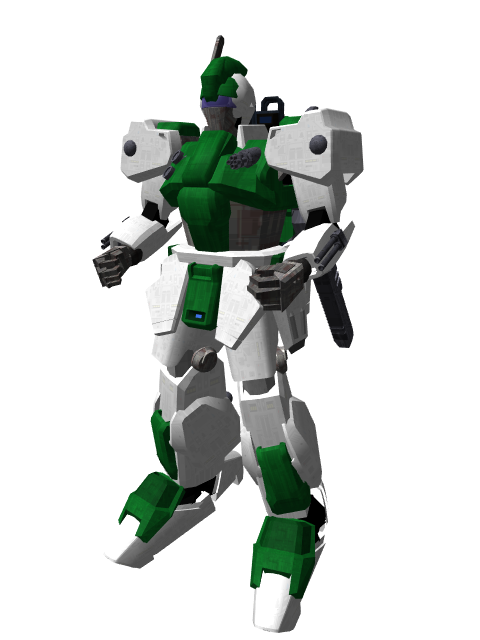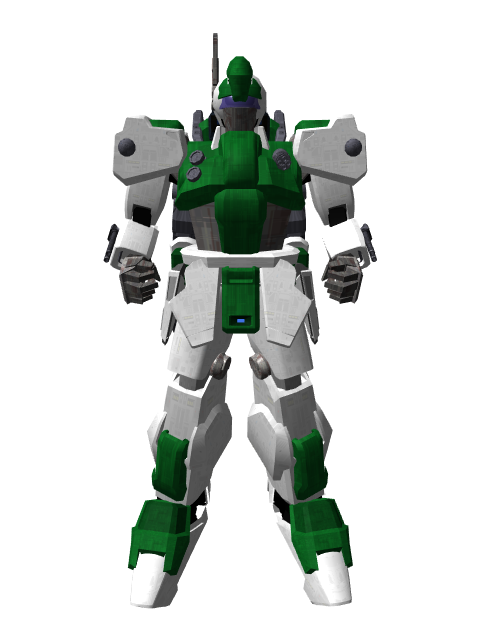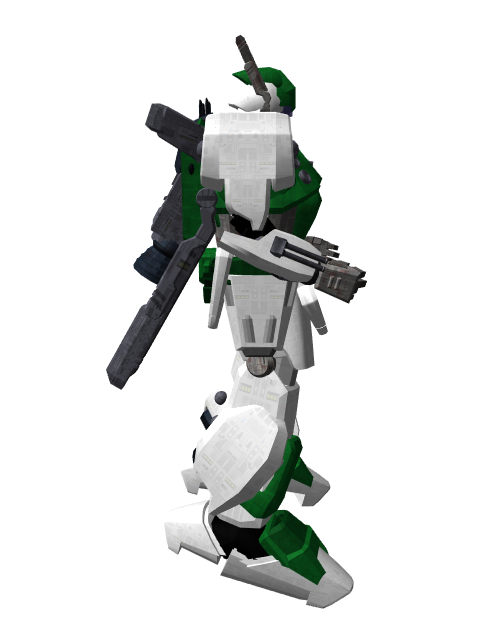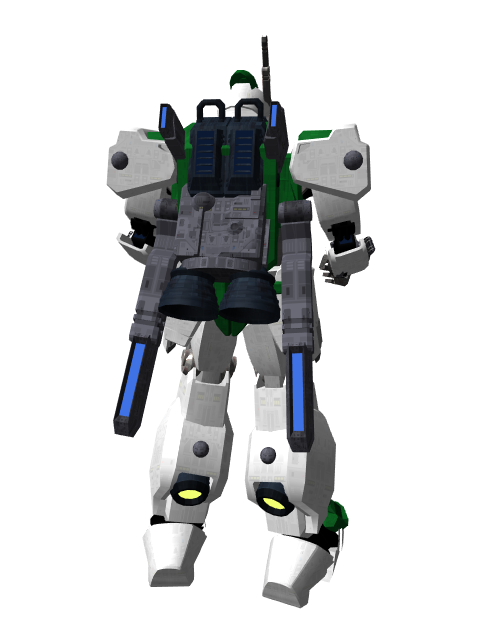Table of Contents
M5 Knight
The Knight, Known as the 'Kishi' in some markets, is a high-performance Powered Frame made by Origin in YE 36
History and Background
Developed in YE 34 alongside the Gekido, the Knight/Kishi is a high-performance frame that was designed to meet the aspirations attempted by the original M1 Series frames. The M1 series, while successful in terms of an experimental, data-gathering venture, proved to be too complex to be used in regular service. Hampered by their own weight and lack of power, the M1 series was struck a further blow by corporate espionage releasing the Ashigaru's blueprints to the general public. The Gekido, and thereby the Knight, were designed around a different system, decided upon after pouring through mounds of battle data gathered from the M1 series, and were also extremely simplified, stripping the new frames of unnecessary weight and allowing them to have more effective armor and systems in place. The advent of a new computer system, the FATE, finally allowed OAW to create the frame system that they had originally set out to build.
Unfortunately, Internal drama and Budget cuts proceeded to shut down the M5 program just short of production, and the Frame was left as just a bunch of blueprints and a half-completed prototype until sudden funding was injected into the program two years after it was supposed to have kicked off.
About the Knight
The M5 Knight/Kishi is Origin's most advanced Armored Frame as of YE 36. It is a high-performance frame which was designed for use by skilled pilots, as opposed to its compatriot the OI-M3-1A Gekido, which was designed to be an all-purpose unit that was intuitive to use and easy to field. The M5's control system has a rather steep learning curve, and the frame itself is extremely powerful, due to having been fitted with a starship powerplant. While Quite capable on the ground, the M5 is also designed to be extremely fast and maneuverable in space as well, allowing it use in a wide variety of roles which is predecessors weren't nearly as effective in. Essentially an 'ace' unit, the M5 Knight uses much of Origin's best technology, but, being designed in concert with the M3 Gekido, shares a certain amount of parts and structure commonality with the much less expensive frame.
Appearance
The M5 Knight/Kishi is a large Humanoid frame which consists of a system of armored plates and components joined in a Humanoid form. It has large feet, Thrusters on several parts of its body, including the backs of the calves, and has somewhat large shoulders. The right side of the head sports a short, thick antenna. The Main thrusters are mostly attached to a large backpack unit in the rear. The left side of the chest contains a small Vulcan, while the right side contains two Chaff/flare tubes.
Statistical Information
- Government: N/A
- Organization: Origin Industries
- Type: High-Maneuverability Assault Frame
- Class: OI-M5-1A Knight/Kishi
- Designer: Origin Armor Works
- Manufacturer: Origin Armor Works
- Production: Limited.
- Cost: 100,000 KS
- Crew: 1
- Maximum Capacity: 1
- Width: 5 Meters
- Height: 10 Meters
- Mass: 20 Tons
Speeds
- Ground Speed (Running): 150 KPH
- Ground speed (Hover): 250 KPH
- Air speed: Mach 2
- Zero Atmosphere: .325 c
- Range: Up to 12 days on Land. 6 Days in Space
- Lifespan: 10 Years
Damage Capacity
See: Damage Rating (Version 3) for an explanation of the damage system.
- Hull: Tier 8 1)
- Shields: Tier 8
Interior Description
There are numerous systems put together to ensure the M5 is capable of performing its intended job.
Cockpit
The Cockpit is the interface between the pilot and their machine, and the M5 uses a specialized version of the standard cockpit.
See: Origin Standard Frame Cockpit
The M5's Frame Cockpit is the same as the standard, except for the fact that it only comes in a Single-seat configuration, and uses the M5 control system as opposed to the standard control harness.
Weapons Systems
The M5 Knight has numerous built in weapons, as well as the capability and flexibility to carry more, either handheld, or mounted to hardpoints on the Frame itself.
(6): Ultraviolet Laser Nodes
A multipurpose laser weapon with rate of fire inverse to beam power. It operates in the ultraviolet spectrum and has effects similar to projectiles rather than energy weapons punching into and boring through substances more than melting them.
The ULN's are controlled by the Frame's AI.
(2): Chaff/flare launchers
Located on the right side of the chest (The left if looking from the front), these two launch tubes contain chaff and flares which are fed by rotary magazines. The Chaff and Flares are used to distract enemies, disrupt sensors, and as a general signal. Each tube has eight rounds, Chaff in the upper tube, flares in the lower.
The Chaff/Flare launchers are activated by the Thumb trigger on the right Yoke
(1): Anti-personnel Vulcan
The Knight has a chest-mounted 12.7mm chemically-propelled Vulcan for anti-personnel and light anti-armor duties.
- Power: Tier 3
- ROF: 30 RPS
- Ammo: 1,000 rounds
- Range: 500 meters
The Vulcan is activated by the Thumb trigger on the left Yoke
(4) 25mm Auto-Gauss Guns
Inside each of the Knight's forearms are two stripped-down OI-M3-W3301 25mm Machine Pistol assemblies, each with 200 rounds stored in belts inside the Frame's forearms, giving a total of 800 rounds for these weapons.
The Gauss Cannons are activated by the Middle Finger triggers on either Yoke
Optional Weapons
The M5 is capable of wielding a wide variety of non-integrated weapons systems, and though not recommended, weapons and accessories from older models as well.
See: M3 Frame Accessories OR M5 Series Frame Accessories
- The Primary weapons for each hand are activated by the Index triggers on either Yoke.
- The Shoulder Weapons are activated by the Ring finger trigger on either Yoke.
- The Calf Weapons are activated by the Pinkie Trigger on either Yoke.
Systems Descriptions
As with any war machine, a number of systems work together to enable the M5 Knight to perform its intended tasks.
Hull and Hull Integrated Systems
The Hull of the M5 Knight is attached to the frame, however, there are some systems integrated into the hull itself, as well as the frame.
Hull and Chassis
Armor plating on the M5 is primarily composed of interlocking Durandium Alloy alloy plates. Coatings of Endurium up to three inches thick are then applied to a surface which is face hardened beforehand. The internal frame, or skeleton, is composed of Durandium Alloy with ADNR reinforcement arranged in supportive matrix; the tough Durandium alloy allows the frame to flex to a certain degree in response to kinetic energy, while the ADNR provides rigid support, preventing the skeleton from bending too far and warping.
The large plates of the M5 are secured with a special fastening system which is linked directly to a mechanical kinetic energy buffer system to absorb impacts, and is easy to remove with just a few tools. This system also plays a key role in the ease of customization and modularity of the frame, as the armor on the hips, forearms, shoulders and calves may be removed to mount various weapons and other accessories.
Key points such as the hands and feet are specifically reinforced to allow for physical combat with significantly mitigated damage.
Multipurpose Articulated Grip System
See: Multipurpose Articulated Grip System
There are Five of these on the M5, one on the back of each shoulder, one on each hip, and one on the rear skirt armor.
Modular Hardpoint System
Designed with modularity in mind, the M5 can have multiple weapons and accessories mounted on its hard points. Primary locations for mounting equipment include the shoulders, forearms, hips and calves. Additional options are available, allowing for the entirety of the frame to be customized, taking advantage of the frame's armor construction and it's ease of removal and replacement.
See: M3 Frame Accessories
Shields
Defensive shield generation stems from three separate units, one located under the cockpit and one roughly under each shoulder blade. This provides a level of redundancy, as a decentralized defensive system is more difficult to completely destroy. A generator unit consists of two separate types of defensive field emitters, one electromagnetic and the other gravitic. Despite close proximity, there is little to no interference between the two different shield generator types. Upon the loss of a shield generator, the remaining units may overclock their performance in order to compensate for the loss and maintain normal shield integrity for a short amount of time.
Power Generation
The M5 Knight is a very powerful Mecha, and as such comes with a very powerful power generation system.
SLAM
A single SLAM provides most of the power for the M5, located inside the heavily armored chest. Specially shaped armor plates protect the SLAM, and serve to direct a portion blast in the case it is breached, allowing for the explosive force to be directed away from the cockpit in event of breach, increasing crew survivability. The SLAM is somewhat difficult to service, as it requires the removal of several of the chest plates in order to access, but once those have been lifted, the reactor itself will slide right out after its anchors have been unfastened.
Because the SLAM is designed for starships, its output is vastly higher than what is considered sane to place in a Powered Frame. This results in a frame with extremely high performance.
BURST
four BURST reactors are placed off center from the main reactor and towards the back, with two in the Frame's calves, and the other two above the main reactor and offset to the left and right respectively. They serve to provide additional power for the frame, and ensure operation in the case of main fusion core failure. With only the BURST units functioning, the M5 is capable of self locomotion with the limbs and shielding or weapons operation. The units do not provide enough power to keep shielding and weapons that draw from the frame's energy grid running at the same time, so only one or the other may be operated when the main power source is inactive.
Propulsion
The M5's primary propulsion system is a heavy fusion thruster system that feeds from the Five reactors inside the frame. Due to the abundance of energy sources, the system has a high power to weight ratio, allowing the frame to reach it's top speed quickly. Besides the primary nozzles and verniers, there are additional thrust vectoring ports located throughout the frame's hull, mounted on hard points to ensure they do not stress weak components.
Life Support
See: Origin Standard Frame Cockpit
Life support is housed inside the Cockpit. It consists of air scrubbers, pressurized cabin, thermo-regulation, thermal shielding, radiation shielding and a gravimetric field to protect against graviton attacks and kinetic shocks. These systems are all powered by a single PUNCH safely tucked away from the pilot, and can all function so long as the PUNCH has fuel.
Frame Advanced Tactical Electronics Suite
The Frame Advanced Tactical Electronics Suite, or FATE, provides various subsystems for the M5. Besides providing functions ranging from sensors to fire control, the FATE has simplified production and maintenance without sacrificing durability of the systems. More powerful and capable than its predecessor, the PAWN-IES.
See: FATE Type A
Notes
I'll admit it. This is supposed to be kind of like a Gundam. - Kai
Contains everything it needs and nothing that it does not. You has an Osaka seal of approval :3 - Osaka/Osakanone
Update: What is the current generation of powered-frames? Would this count as a next-gen unit? Osaka/Osakanone
OOC Notes
This page was originally created on 2014/01/25 22:43 by Kai.



